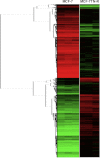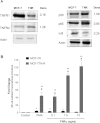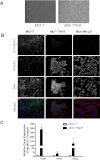Altered death receptor signaling promotes epithelial-to-mesenchymal transition and acquired chemoresistance
- PMID: 22844580
- PMCID: PMC3406343
- DOI: 10.1038/srep00539
Altered death receptor signaling promotes epithelial-to-mesenchymal transition and acquired chemoresistance
Abstract
Altered death receptor signaling and resistance to subsequent apoptosis is an important clinical resistance mechanism. Here, we investigated the role of death receptor resistance in breast cancer progression. Resistance of the estrogen receptor alpha (ER)-positive, chemosensitive MCF7 breast cancer cell line to tumor necrosis factor (TNF) was associated with loss of ER expression and a multi-drug resistant phenotype. Changes in three major pathways were involved in this transition to a multidrug resistance phenotype: ER, Death Receptor and epithelial to mesenchymal transition (EMT). Resistant cells exhibited altered ER signaling, resulting in decreased ER target gene expression. The death receptor pathway was significantly altered, blocking extrinsic apoptosis and increasing NF-kappaB survival signaling. TNF resistance promoted EMT changes, resulting in a more aggressive phenotype. This first report identifying specific mechanisms underlying acquired resistance to TNF could lead to a better understanding of the progression of breast cancer in response to chemotherapy treatment.
Figures






Similar articles
-
The NF-κB Pathway Promotes Tamoxifen Tolerance and Disease Recurrence in Estrogen Receptor-Positive Breast Cancers.Mol Cancer Res. 2020 Jul;18(7):1018-1027. doi: 10.1158/1541-7786.MCR-19-1082. Epub 2020 Apr 3. Mol Cancer Res. 2020. PMID: 32245803 Free PMC article.
-
Inhibition of p38 mitogen-activated protein kinase alters microRNA expression and reverses epithelial-to-mesenchymal transition.Int J Oncol. 2013 Apr;42(4):1139-50. doi: 10.3892/ijo.2013.1814. Epub 2013 Feb 8. Int J Oncol. 2013. PMID: 23403951 Free PMC article.
-
IRF-1 inhibits NF-κB activity, suppresses TRAF2 and cIAP1 and induces breast cancer cell specific growth inhibition.Cancer Biol Ther. 2015;16(7):1029-41. doi: 10.1080/15384047.2015.1046646. Cancer Biol Ther. 2015. PMID: 26011589 Free PMC article.
-
The dual role of tumor necrosis factor-alpha (TNF-α) in breast cancer: molecular insights and therapeutic approaches.Cell Oncol (Dordr). 2020 Feb;43(1):1-18. doi: 10.1007/s13402-019-00489-1. Epub 2020 Jan 3. Cell Oncol (Dordr). 2020. PMID: 31900901 Review.
-
NF-κB signaling in neoplastic transition from epithelial to mesenchymal phenotype.Cell Commun Signal. 2023 Oct 18;21(1):291. doi: 10.1186/s12964-023-01207-z. Cell Commun Signal. 2023. PMID: 37853467 Free PMC article. Review.
Cited by
-
Helicobacter pylori-activated fibroblasts as a silent partner in gastric cancer development.Cancer Metastasis Rev. 2023 Dec;42(4):1219-1256. doi: 10.1007/s10555-023-10122-1. Epub 2023 Jul 17. Cancer Metastasis Rev. 2023. PMID: 37460910 Free PMC article. Review.
-
Argonaute 2 Expression Correlates with a Luminal B Breast Cancer Subtype and Induces Estrogen Receptor Alpha Isoform Variation.Noncoding RNA. 2016 Sep 21;2(3):8. doi: 10.3390/ncrna2030008. Noncoding RNA. 2016. PMID: 29657266 Free PMC article.
-
The role of TNF-α in chordoma progression and inflammatory pathways.Cell Oncol (Dordr). 2019 Oct;42(5):663-677. doi: 10.1007/s13402-019-00454-y. Epub 2019 Jun 7. Cell Oncol (Dordr). 2019. PMID: 31175552
-
EMT signaling: potential contribution of CRISPR/Cas gene editing.Cell Mol Life Sci. 2020 Jul;77(14):2701-2722. doi: 10.1007/s00018-020-03449-3. Epub 2020 Feb 1. Cell Mol Life Sci. 2020. PMID: 32008085 Free PMC article. Review.
-
Epithelial to Mesenchymal Transition: A Mechanism that Fuels Cancer Radio/Chemoresistance.Cells. 2020 Feb 12;9(2):428. doi: 10.3390/cells9020428. Cells. 2020. PMID: 32059478 Free PMC article. Review.
References
-
- American Cancer Society. v. (The Society, AtlantaGA, 2011).
-
- Seidman A. D. Chemotherapy for advanced breast cancer: a current perspective. Seminars in oncology 23, 55–59 (1996). - PubMed
-
- Baker S. J. & Reddy E. P. Modulation of life and death by the TNF receptor superfamily. Oncogene 17, 3261–3270 (1998). - PubMed
-
- Vandenabeele P., Declercq W., Beyaert R. & Fiers W. Two tumour necrosis factor receptors: structure and function. Trends Cell Biol 5, 392–399 (1995). - PubMed
Publication types
MeSH terms
Substances
Grants and funding
LinkOut - more resources
Full Text Sources
Medical

